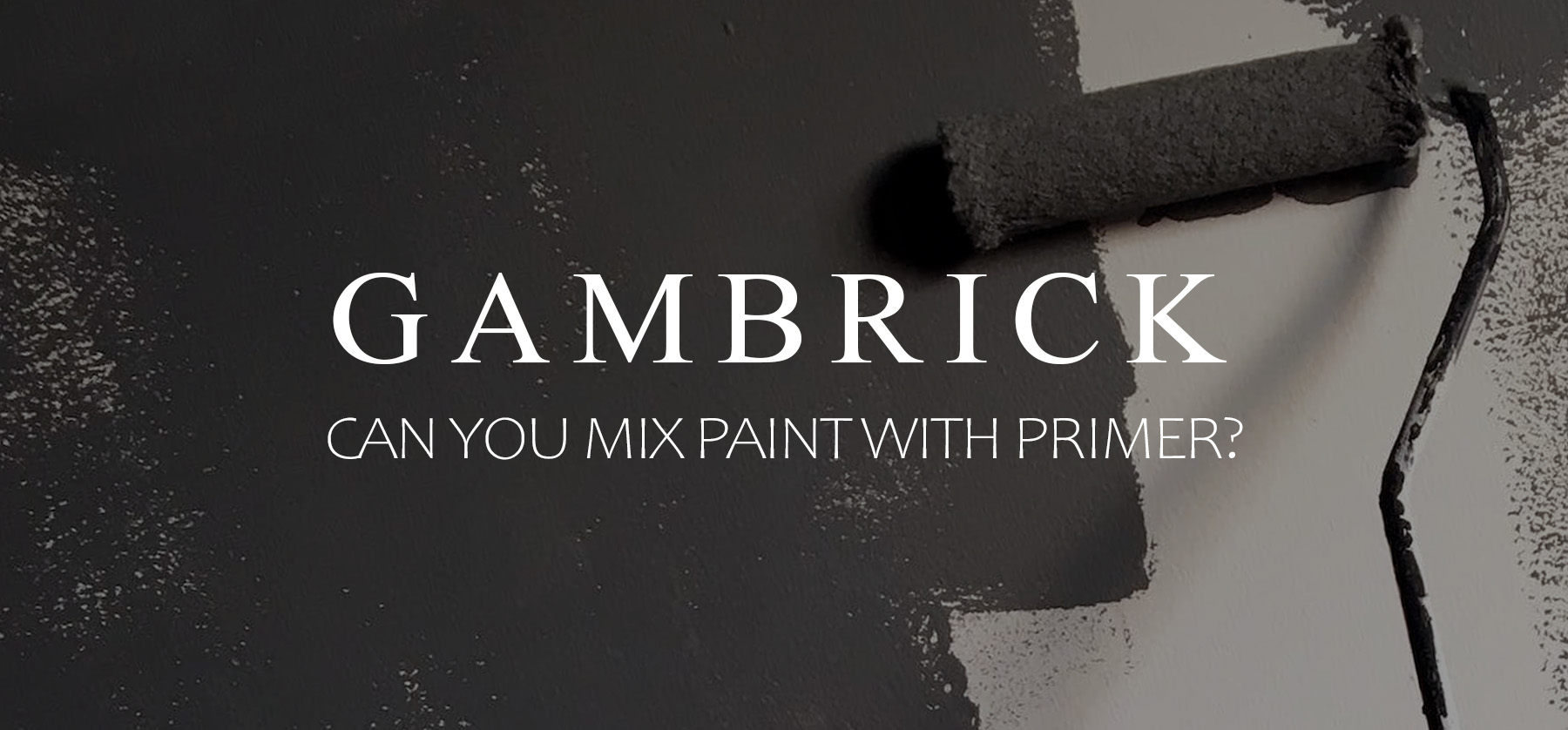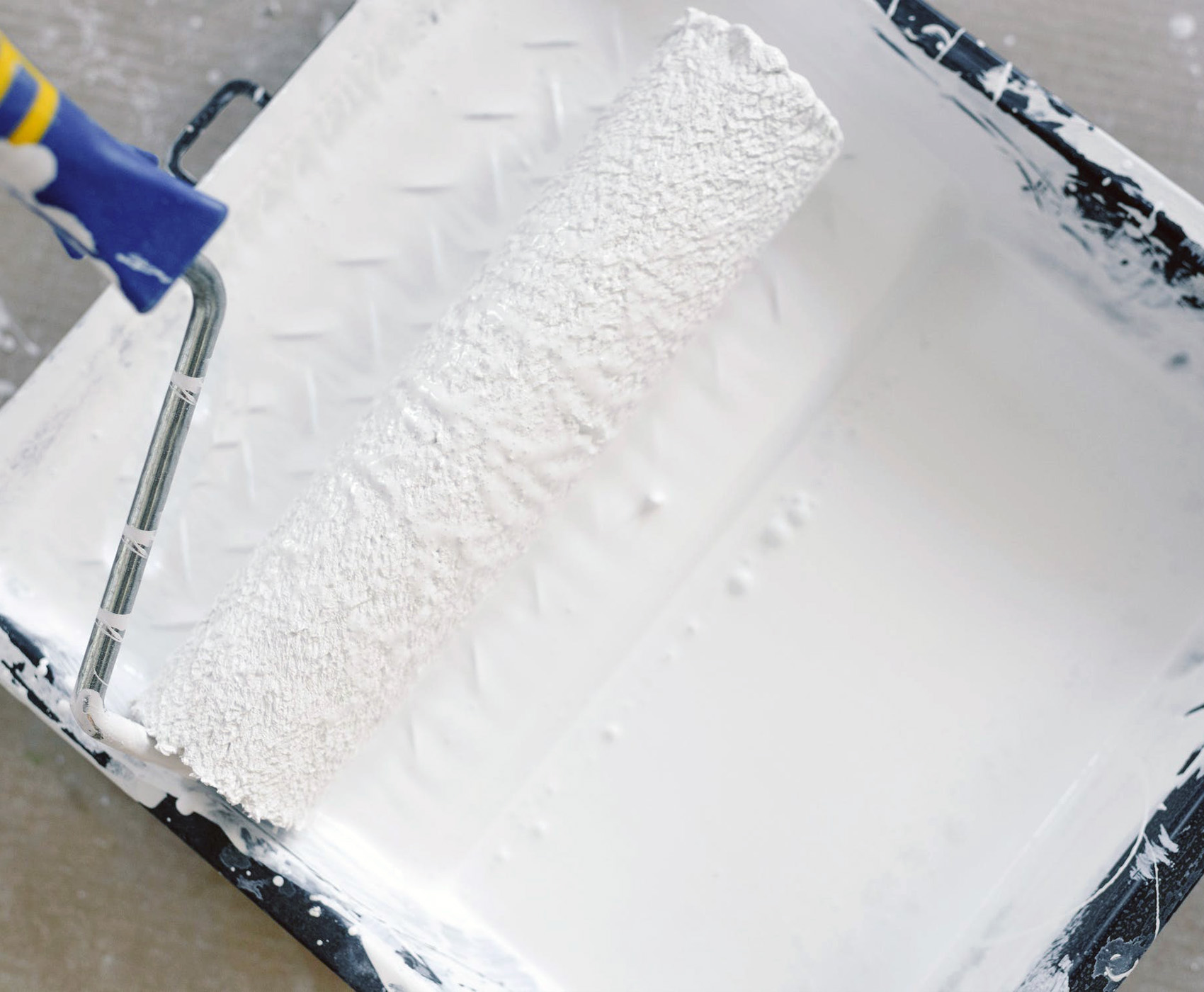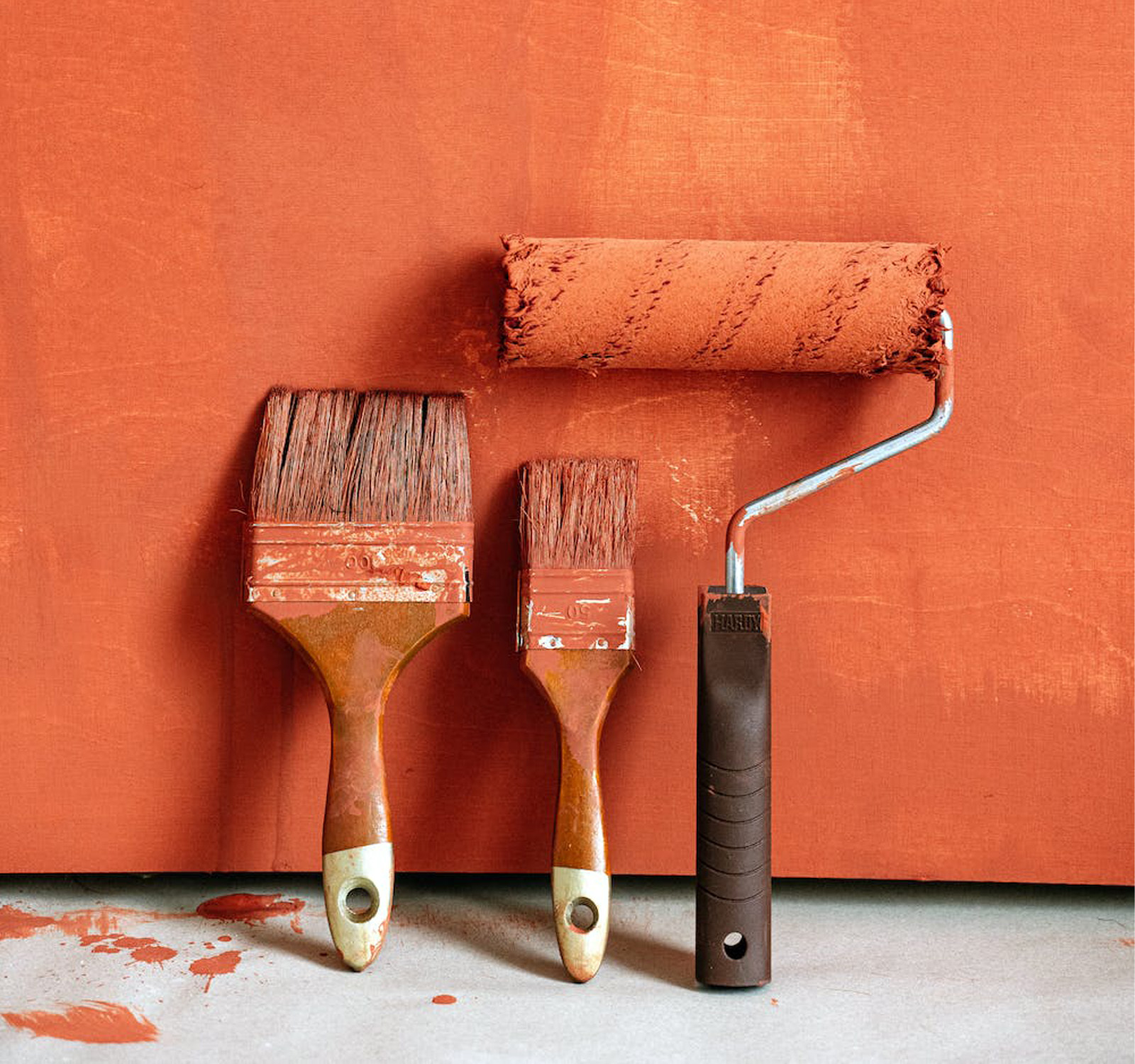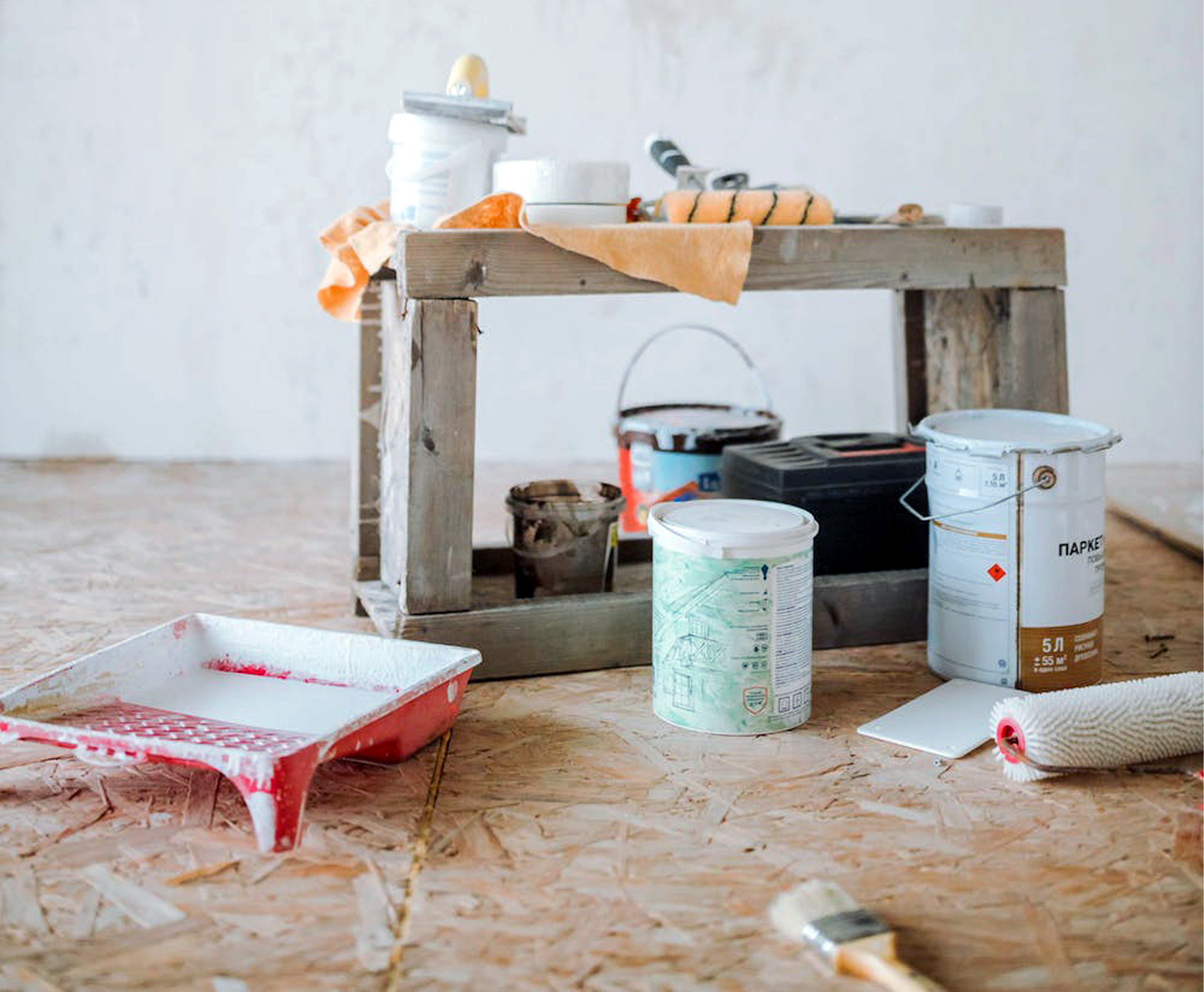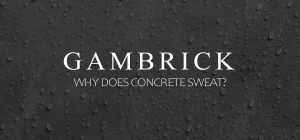Can You Mix Paint With Primer?
You can mix paint with primer, but it changes the properties of both the paint and primer. It’s better to use a 2-in-1 paint/primer combo or to apply primer and paint separately in thin coats. Paints and primers are chemically formulated to do different things. Paint is designed to add color to a surface. It’s thin and looks best when applied over a light neutral base. But primer is designed to cover stains, discolorations and bold colors. It’s thick and harder to work with.
When you mix paint and primer together, you weaken the primer and thicken the paint. This makes both less effective than they should be. However, it can still be done. I do it all the time in small amounts if I’m running out of paint, when both colors are white (such as with ceiling paint), or I want to lighten my paint a little bit with some white primer.
- You can tint a primer with a little bit of color from a paint.
- Thicken paint up and make it cover better by adding a little primer.
- If both the primer and paint are the same color, such as white, mixing them together is generally fine.
- You can lighten paint by adding a little white primer.
- Mixing paint and primer together also reduces the effectiveness of the sheen and UV protection in the paint.
By mixing paint and primer together, you water down both substances which reduces the effectiveness of both. If the paint has UV protection or a sheen, both will be lessened by however much primer you add.
It’s best to use a 2-in-1 paint/primer combo than to mix paint with primer yourself. Or apply apply 1–2 coats of primer followed by 1–2 coats of the paint is separate coats.
Paint And Primer Mix Ratios
When you mix paint and primer together DIY, you need to use the correct ratios. Paint and primer are chemically formulated to do different things. paint is a finish coat that provides color, a sheen and some UV protection to prevent fading. Primer is a base coat that adheres better than paint, cover stains and smooth the surface you’re eventually painting.
When you mix paint and primer together, you water down the properties of both. The result is a less effective paint or primer. However, there are some instances where it’s beneficial to do it.
For example, I mix some primer in my ceiling paint because it makes it adhere and cover better without much drawback because ceiling don’t need as much sheen or UV protection as walls.
I also occasionally mix some paint in my primer when I want a slight tint to the color.
- If you mix primer into your paint, the ratio you should use is 10%-15% primer mixed with 85%-90% paint.
- If you mix paint into primer, the ratio is 5%-15% paint mixed with 85%-95% primer.
By mixing just a little paint or primer to the other, you get some benefits without as many drawbacks caused by watering down either the paint or primer.
Things To Know About Paint
Paint is designed to add color to a surface, not to cover old surfaces. If you’re painting over stains, discolorations or an old paint job, it’s best to use a primer first. Applying paint over dark colors is a bad idea because the stains will show through. Paint is too thin to be used for coverage.
To make paint more durable, additives are used to give it a protective sheen and/or UV protections. If you add primer to the mix, these protective elements will be reduced by the volume of primer you added. However, the primer will make the paint thicker and give it better coverage.
- Use paint with a high viscosity so you don’t have to use as many coats to cover a surface. This will save you time and money.
- Paint is designed to dry smooth. If you add primer to the mixture it will make the paint thicker which could also make it dry less smooth.
- Good quality paints are durable and resist cracks or chips because they contain a sheen. Adding primer to the mix waters down the protective sheen which reduces paints durability.
- Water-based paints mix well with other water-based paints. The same is true of oil-based paints. But they don’t mix well together. If you are going to mix paint and primer, make sure they’re both either water-based or oil-based.
- Water-based paints are better for interior use while oil-based paints are for the exterior.
As a rule, I always prime before I paint or use a 2-in-1 paint/primer combo. The only time I’ll use paint alone is when painting over a while surface that’s not stained.
Things To Know About Primer
Primer is a base coat that creates a foundation for the paint job. It’s more adhesive than paint so it sticks to just about any surface. It’s also thick and less translucent which makes it ideal for covering stains or bold colors. Using primer before you paint is essential to creating the best possible paint finish with the least amount of coats.
In general, primer is cheaper than paint, so it’s almost always better to apply primer before you paint. However, a good quality 2-in-1 paint/primer combo can be used to go over mild stains and medium dark colors.
- A primer coat helps paint adhere to the surface you’re painting.
- Primers are thicker and stick better to surfaces than paints.
- Priming before painting helps paint last longer without chipping or flaking off.
- Priming wood gives it more durability against the elements and bugs.
- If you’re going over an old paint job, primer helps reduce the number of paint coats it takes to cover.
- Primer can cover up stains, discolorations or bold colors from older paint jobs.
- Primer can stick to glossy surfaces but paint generally can’t.
- Primer is generally cheaper per gallon vs paint.
- Using primer saves money because it reduces the amount of paint it takes to cover a surface.
- A primer is essential for porous surfaces like unfinished wood, drywall, and masonry which absorb lots of paint.
It’s OK to mix paint with a little primer, but keep in mind that you diminish the qualities of both when you mix them together.
I occasionally mix paint and primer together when they’re both white, for example with ceiling or trim paint. And I sometimes tint my primer coat with a little paint color. A 10%-15% primer to 90%-85% paint ratio is a pretty good mix.
Positives Of Mixing Paint With Primer
While mixing paint with primer isn’t the best way to paint. You’re generally better off using a 2-in-1 paint/primer combo or applying primer and paint separately, there are some benefits to occasionally doing it in small amounts.
- Mixing paint and primer thickens paint and gives it better coverage.
- Adding some primer to paint works well for interior walls ad ceilings that aren’t badly stained or are a light color.
- A paint and primer mix can reduce the amount of coats you need to apply.
- Mixing the two works well if they’re both the exact same color.
I don’t recommend mixing paint and primer on a regular basis for a large paint job, but it’s fine when done in small amounts. I do it once in a while when painting walls, trim or ceilings white because both the primer and paint matches so closely. If the walls aren’t dark or stained it reduces coats and the overall job time.
When mixing paint with primer, I use a 10%-15% primer to 90%-85% paint ratio. With a mix ratio like this, you don’t lose much of the paints sheen or UV protection but you gain a little better coverage.
Negatives Of Mixing Paint With Primer
The biggest downfall of mixing paint and primer is that you reduce the effectiveness of both. Paint and primer are formulated to do different things. Paint is thinner and designed to add color to a surface. It typically contains a sheen and other additives which increases its durability. While primer is a very adhesive thick base coat that’s designed to be painted over.
When you add primer to your paint, it thickens the paint and gives it some additional adhesion and coverage. But it waters down the protective elements and changes the color.
When you add some paint to primer, you reduce its adhesion and thickness but add a tint of color.
- Adding primer to paint will change the color and reduce its protective elements.
- Adding paint to primer thins it and adds some color.
- Mixing paint and primer works best if they’re the same color, such as grey or white.
- Adding a little primer to paint works well when painting interior walls, ceilings and trim that’s aren’t stained or painted with a bold color.
While I don’t recommend mixing paint and primer on every job, sometimes it’s OK. If the walls are neutral, light and aren’t stained, I mix some primer in my paint to thicken it up and give it better adhesion and coverage. I use a 10%-15% primer to 90%-85% paint ratio.
I would not recommend mixing paint and primer if the surface is dark, stained or glossy. In this case you need 1-2 primer coats followed by your paint. But it would be fine to add a little primer to the paint as long as the surface is properly primed.
Buyer Checklist
One of the best ways to achieve a professional level paint job is using high quality paints. I’ve painted hundreds of homes on the exterior and interior, fences, patios, walls, decks, porches, etc. And the best results come from preparation, proper use of primers and using the right paint at the right time.
Here are some tips to keep in mind when shopping for paint and primer.
Things To Look For While Buying Paint
- Consider using latex paints. They last longer and are more durable.
- A high-viscosity paint/primer will smooth out and drip slower which results in a better finish.
- Use a paint with some UV protection to reduce fading.
- Some level of sheen is important because it protects the paint from scratches.
- Use at least an eggshell sheen for walls and semi gloss for trim and doors.
- White with a flat finish is the standard color and sheen for ceilings. Since no one will touch the ceiling you don’t need a sheen.
- More expensive paint tends to be better than cheaper brands and has better coverage. Even though you pay a little more for the paint, it saves time and money in the long run because it takes less coats to paint a surface and generally lasts longer.
- I don’t recommend using 1 coat paints. Every time I’ve tried them they’re left streaks or spots without total coverage. 2-3 thin coats is generally best.
Things To Look For When Buying Primer
Choosing the right type of primer is very important because they’re not all created equal. Some primers are better for wood, some for masonry, some are designed for interior use and some for exterior surfaces.
Select a primer for the type of surface you’re using it on and the location. Remember a primer is a base coat that’s designed to be painted later. It’s not supposed to be a finish.
- I use a latex primer or an oil-based primer on wood.
- Use a stain blocking primer if you’re covering dark stains.
- I prefer using water-based primers indoors because they don’t smell as bad.
- Oil based primers work really well but they smell toxic. I never use them indoors and only rarely outdoors.
- I use an oil-based primer to go over exterior paint jobs that are in bad shape. But you must prep the surface first by sanding and chipping old paint off as much as possible.
- I prefer a sandable primer to the the surface as smooth as possible before I paint.
- Make sure to use a masonry primer on masonry because it’s designed to breathe.
- Primer is generally cheaper than paint but use as high a quality primer as you can afford. It will generally have better coverage and more stain blocking which always saves me time and money.
2-In-1 Paint Primer Combos
Although mixing paint and primer together in small amounts is generally OK, it’s better to use a paint/primer combo. These mixtures are specially formulated paints with a small amount of primer to increase adhesion and coverage. They work similar to mixing paint and primer together by yourself, except the ingredients are altered to not reduce the benefits of the paint’s sheen, color or UV protection.
I recommend buying a two in one because the chemicals and properties are formulated at the factory to balance each other out. When you mix the paint and primer together yourself, you reduce the effectiveness of both the paint and the primer.
Two-In-One Primers are great to use when:
- You’re repainting a wall the same color: When you paint a wall the same color or a color that’s really close, you don’t need a full primer coat. But some primer helps create even coverage and hides small discolorations.
- You’re painting new drywall: New drywall doesn’t need a full primer coat because there shouldn’t be dark stains. A small amount of primer in your paint is usually enough. However, if the walls have dark writing or spots use a primer coat followed by paint or a 2-in-1.
- The old color is light: A 2-in-1 works great if you’re painting over an old light color that’s not stained.
- The surface isn’t porous: If you’re painting a flat and smooth surface, a 2-in-1 can work really well. However, for porous surfaces and masonry use a primer first.
When to use a 2-in-1 is very situational. They’re basically paint with a little bit of primer. So use them when all you need is a small amount of additional coverage and not a full primer coat.
Is Mixing Paint With Primer The Same As 2-In-1 Paint?
Mixing paint and primer together is not the same as buying 2-in-1 paint that’s mixed at the factory. Paint is formulated to add color to a surface as a finish coat. It typically contains a sheen and some protective ingredients to increase its durability. Primer is designed to be a base coat. It’s thicker than paint, covers better and has more adhesion. But it’s not a finish. When you mix paint and primer together, you diminish the properties of both the paint and primer.
2-in-1 paint and primer combo is formulated at the factory to contain both paint and primer. The ratio is usually 10%-15% primer to 85%-90- paint. But neither the paint or primer is watered down by the other because their ingredient ratios are formulated to work together.
When you mix paint and primer together at home, the ingredient ratios are not designed to work together so they can counteract in the following ways:
- Mixing paint and primer together will water down both
- Adding primer to paint changes the color of the paint while increasing adhesion, coverage and thickness
- Adding paint to primer thins it and adds a tint of color
- Paint and primer have different chemical formulas
Many 2-in-1 paints are actually just paint with more paint solids. By increasing the amount of paint solids in the paint, it has better coverage and thickness.
Some true 2-in-1 paint and primer combos are 10%-15% primer to 85%-90- paint. By adding primer to paint, the mixture has better adhesion and coverage.
Self-priming paints are typically more expensive than buying traditional primer and paint.
Top Reasons You Should Not Mix Primer With Paint
Mixing paint with primer is OK for some jobs, in small amounts. For example, I do it occasionally when both the paint and primer are the same color and I’m painting ceilings, trim, doors, railings, etc. It you add 10%-15% primer to your paint, it increases the paint’s adhesion and coverage while making it a little thicker. But it also diminishes the sheen, can change the color and reduces UV protection in the paint.
It’s almost always better to use a 2-in-1 paint and primer combo or to apply primer and paint separately rather than mixing the two together.
Mixing paint and primer together does not create a 2-in-1 paint. 2-in-1 is specifically formulated to contain both paint and primer. The chemical properties and ingredient ratios in both paint and primer are adjusted to work together at the factory. This isn’t something you can do at home.
Here are the top reasons why you should not mix paint and primer together:
The Primer Won’t Cover Or Seal As Well
The primary job of primer is to create a base coat for paint. It’s designed for maximum coverage to go over dark stains or bold paint jobs. By adding paint to the primer, you water it down by the volume of paint you added. This reduces its ability to cover dark colors.
Primer is also designed to seal a rough and porous surface. This helps prevent future coats of paint from soaking into the surfaces pores because paint is much thinner than primer.
When you mix paint with primer, you diminish the primer’s ability to seal and cover. Dark colors could show through the paint/primer mix it won’t seal the surface as well.
Less Adhesion
Primer is designed to adhere to a variety of surfaces. It’s a thick and sticky substance that will cover just about anything. But paint is thinner and doesn’t adhere as well. This is why paint alone is so prone to chipping, flaking and peeling off over time.
For the best possible paint job, you should prime a surface followed by paint. Priming first creates a smooth surface that your paint can stick to.
- When you add paint to your primer, you diminish the primers ability to stick to surfaces.
- When you add primer to paint, you increase the paint’s ability to adhere, but you decrease its sheen, UV protection and change the color.
You should almost always prime a surface before painting. It creates a smooth paintable surface for your paint and covers old stains and paint jobs.
Paint Texture
Priming is an important step when painting for the first time. The primer coat is applied first because it adheres better than paint and creates a smooth surface for the paint to adhere too. Primer is thicker than paint, so it helps smooth out rough and porous surfaces.
If you paint directly onto a surface without primer, the texture is usually less smooth. Because paint is so thin, it doesn’t have the same ability to smooth out rough surfaces like primer does.
Altered Color
Adding primer to paint will change the color of the paint. Most primers are either white or grey unless you tint them. Depending on your paint color, adding primer could make it lighter, darker or greyish. The result could be a paint that’s too light, too dark, too grey or muddy.
You could also have the problem of matching colors. Once you alter a gallon of paint’s color by adding some primer, you change the paint code. If you need another gallon for touch ups later on, you’ll have to mix the exact color yourself DIY. This can be difficult to do. If you don’t get it just right, your new paint won’t match the old.
The only time I mix a little primer in my paint is when they’re the same color, usually white. It works well for ceilings, trim, doors, railings etc. A little white primer added to white paint in a 10%-15% primer to 85%-90% paint ratio can increase adhesion and coverage without many drawbacks.
Decreased Durability
Paint usually has additives mixed in like a sheen and UV protection which increase its durability and prevents fading. But primer doesn’t. Primer is designed to be a base coat that gets painted. So primer lacks protective elements which are put into the paint instead. When you add primer to paint, you decrease the amount of these protective ingredients by the volume of primer you add. This means your paint will be more prone to scratches and fading.
Will Adding Primer Primer To Paint Lighten the Color?
Adding primer to paint will alter the color of the paint. But it won’t necessarily lighten it. How the paint color changes depends on the color of the paint and the primer. Most primers are either white or grey. Adding white primer to paint will lighten the color. But adding grey primer to paint could lighten it, darken it or make it grayish.
Primer does not contain the same amount of pigment as paint. However it has enough to significantly alter the color of your paint by volume. The more primer you add to the paint, the more you alter the paint’s color.
By adding primer to paint, you also thin out the pigment used in the paint. This has the effect of lightening the paint.
- Primer will make your paint lighter by watering down the pigment of the paint and adding its own pigment to the mix.
- Remember, paint will become even lighter in color when it dries.
Adding primer to a colored paint can be dangerous. The color will be altered and it becomes more difficult to color match the paint. Should you need more paint, you’ll have to mix it DIY. If you can’t match the color perfectly, your paint job will be ruined.
How To Apply Paint And Primer Like A Pro
The best way to achieve a profession paint job is by priming the surface first. Primer is thicker than paint, so it can fill in rough surfaces, cracks and pores to create a smoother surface for the paint.
Start by preparing the surface for primer. Chip off old paint, make repairs and sand where necessary. Then apply 1-2 thin coats of primer. More coats may be needed over dark stains or old paint jobs.
I use a 3/8-inch nap roller to apply my primer. Make sure your primer coats have even coverage and don’t go on streaky. It’s OK if you see some color through the primer because you’ll get better coverage from the next coat.
Wait for the previous coat to dry before applying the next. You can tell if the primer is dry by touching it. Wet primer will feel tacky.
- Start by prepping the surface for primer by chipping off old paint, making repairs or sanding.
- Apply 1–2 coats of primer before painting with a 3/8-inch nap roller.
- Wait until the previous coat is dry before applying the next.
- If you find runs in your primer, sand them down before painting.
- After priming, apply 2 coats of finish paint.
Once you’re all done priming and sanding, apply 2-3 coats of finish paint. Roll the paint onto the surface with a 3/8-inch nap roller, a sprayer and/or brushes. Make sure to apply paint thin and even and avoid runs.
Is It OK To Mix Paint With Primer?
It’s OK to mix paint with primer in small amounts. But it changes the properties of both. It’s better to use a 2-in-1 paint/primer combo or to apply primer and paint separately. Paints and primers are chemically formulated to do different things. Paint is designed to add color to a surface. It’s thin and looks best when applied over a light neutral base. But primer is designed to cover stains, discolorations and bold colors. It’s thick and harder to work with.
By mixing paint and primer, you diminish, or water down, the ingredients found in both. This makes them less effective at doing what they’re designed to do. However, when you add a small amount of primer to paint, it gets thicker, adheres better and has better coverage.
I only add primer to paint when they’re the same color, usually white, and in a 10%-15% primer to 85%-90% paint ratio.
The result of mixing primer and paint are:
- Primer will not seal or cover old stains as well when paint is added to it.
- Primer with paint mixed in won’t adhere as well and won’t dry as smooth over rough and porous surfaces.
- Adding primer to paint changes the paint’s color.
- Adding paint to primer tints the primer’s color.
- Mixing primer in your paint reduces the paint’s sheen and UV protection.
If you want some primer in your paint, it’s better to buy a 2-in-1 paint and primer combo. The manufacturer will alter the ingredient ratios at the factory so that the paint and primer work together rather than watering each other down.
Summary: Can You Mix Paint With Primer?
You can mix paint with primer, but it changes the properties of both. It’s better to use a 2-in-1 paint/primer combo or to apply primer and paint separately. Paints and primers are chemically formulated to do different things. Paint is designed to add color to a surface. It’s thin and looks best when applied over a light neutral base. But primer is designed to cover stains, discolorations and bold colors. It’s thick and harder to work with.
When you mix paint and primer together, you weaken the primer and thicken the paint. This makes both less effective than they should be. However, it can still be done. I do it all the time in small amounts if I’m running out of paint, when both colors are white (such as with ceiling paint), or I want to lighten my paint a little with some white primer.
- Tint a primer with a little bit of color from paint.
- Thicken paint and make it cover better by adding a little primer.
- If both the primer and paint are the same color, such as white, mixing them together is generally fine.
- Lighten paint by adding a light primer.
- Mixing paint and primer together also reduces the effectiveness of the sheen and UV protection in the paint.
By mixing paint and primer together, you water down both substances which reduces the effectiveness of both. If the paint has UV protection or a sheen, both will be lessened by however much primer you add.
It’s best to use a 2-in-1 paint/primer combo than to mix paint with primer yourself. Or apply apply 1–2 coats of primer followed by 1–2 coats of the paint is separate coats.
If you have any questions or comments about mixing paint and primer, email any time.
